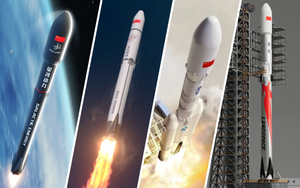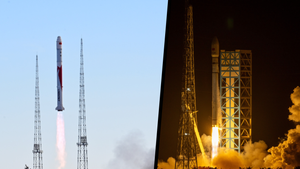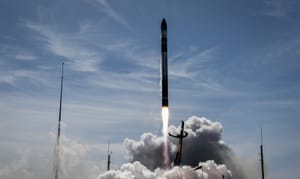
Disclaimer: Launch vehicles that have recently been announced or have had minimal details shared are not included.
SpaceX has slashed the cost of sending satellites into orbit since the introduction of its Falcon 9 launch vehicle in 2010. Over its fourteen-year history, Falcon 9 has flown almost 350 times while capable of lifting up to 22,800 kilograms for a relatively affordable average of sixty million dollars to customers, internal launch costs are thought to be below twenty million dollars. Most impressively, at least half of Falcon 9's launches have occurred in the last three years.
The success of Falcon 9 can be linked to the reuse of its first-stage boosters, which have landed over 300 times and reflown over 270 times to date. Reusing the first-stage boosters has allowed SpaceX to reach its high cadence while keeping costs low, due to the majority of the costly launch vehicle components being in the first-stage.
While SpaceX has been routinely flying Falcon 9, a handful of Chinese launch companies have been working on their own reusable launch vehicles, with most set to debut in the next two years! But what are these launch vehicles?
Zhuque-3
Zhuque-3 is LandSpace's in-development two-stage partially reusable medium to heavy lift launch vehicle targeting a debut in 2025, the debut flight may also see the first landing of a Zhuque-3 first-stage booster. Zhuque-3 plans to burn liquid methane and liquid oxygen propellants in its engines on both stages, which will be built out of stainless steel.
LandSpace claims that Zhuque-3 will be able to lift up to 21,300 kilograms to low Earth orbit when expended, 18,300 kilograms when landing downrange on a drone ship or landing pad, or 12,500 kilograms when returning to the launch site.

The first-stage of Zhuque-3 is planned to be powered by nine TQ-12B engines generating an approximate combined 900 tons of thrust while burning liquid methane and liquid oxygen. LandSpace is also looking to fly each first-stage twenty times, with the potential to certify them for more flights.
The second-stage of Zhuque-3 is planned to be powered by one TQ-15B generating a believed 100 tons of thrust while also burning liquid methane and liquid oxygen.
To facilitate reuse of the first-stage, three engines will be lit during re-entry followed by one being lit again for landing on a drone ship or landing pad. For boost-back burns, the booster will turn around in-flight after separation and relight one engine.
The boosters and second stage are currently planned to have a diameter of 4.5 meters. The fairing is planned to be 5.2 meters in diameter and split into two halves. The total height of Zhuque-3 is currently planned to be 76.6 meters with it having a fully fuelled mass of approximately 660,000 kilograms.
Tianlong-3
Space Pioneer is developing its Tianlong-3 partially reusable two-stage launch vehicle for a debut flight no earlier than late 2024. Tianlong-3 is planned to launch from the Wenchang Space Launch Site, the Jiuquan Satellite Launch Center, and sea-launch platforms.
Space Pioneer currently claims that Tianlong-3 will be able to deliver up to 17,000 kilograms of payload to a low Earth orbit, or 14,000 kilograms to a sun-synchronus orbit.

The first-stage of Tianlong-3 is powered by nine TH-12 engines generating a combined thrust of 820 tons while burning rocket-grade kerosene and liquid oxygen. Tianlong-3's first-stage is currently planned to be reused ten times. The second-stage is powered by a single vacuum-optimized TH-12 engine generating a believed 137 tons of thurst burning rocket-grade kerosene and liquid oxygen.
For reuse of the first-stage, the booster will land vertically on a landing pad or drone ship by relighting between one and three of its engines. Unpowered descent of the first-stage will be guided by four grid fins near the top of the stage.
Tianlong-3's first and second stages are planned to have a diameter of 3.8 meters. The fairing for the launch vehicle is currently planned with a diameter of 4.2 meters and a length of 12 meters. On the launch pad, Tianlong-3 is expected to be 71 meters tall and weigh 590,000 kilograms when fully fuelled.
Pallas-1
Pallas-1 is Galactic-Energy's in-development medium-lift partially reusable launch vehicle with a debut flight expected no earlier than November of 2024. The company currently plans to have the rocket launch from Taiyuan Satellite Launch Center and Wenchang Space Launch Site once in commercial operation.
Galactic Energy has claimed that Pallas-1 will be able to lift up to 8,000 kilograms to low Earth orbit or 5,000 kilograms to a 700-kilometer sun-synchronous orbit. The fairing of Pallas-1 can fit a payload up to 3.8 meters in diameter and 8 meters tall.

Pallas-1's first-stage is powered by seven Welkin engines burning rocket-grade kerosene and liquid oxygen to generate 350 tons of thrust. The second-stage is powered by a single Welkin vacuum-optimized engine also burning rocket-grade kerosene and liquid oxygen to generate 60 tons of thrust.
For reuse, Pallas-1 has four grid fins and four landing legs on the first-stage. The first-stage is planned to be landed vertically, like SpaceX's Falcon 9. It is currently unclear if Pallas-1 will be able to land back at its launch site due to its smaller size.
On the launchpad, the rocket is 42 meters tall with the first and second stages being 3.35 meters in diameter, the fairing is 4.1 meters in diameter and tapers out from the top of the second-stage. Fully fuelled Pallas-1 weighs a believed 283,000 kilograms.
Kinetica-2
CAS Space is currently developing its Kinetica-2 launch vehicle for a debut flight in the Summer of 2025. After a debut in 2025, CAS Space hopes it can recover, and potentially refly, a first-stage booster before 2027.
Kinetica-2 has a claimed payload capacity of 12,000 kilograms to low Earth orbit, or 8,000 kilograms to a sun-synchronus orbit. CAS Space is considering a Falcon Heavy-like configuration to increase the launch vehicles payload capacity.

The first-stage of Kinetica-2 is believed to be powered by nine 85 tons of thrust engines that burn rocket-grade kerosene and liquid oxygen for a total of 766 tons of thrust. Kinetica-2's second-stage is thought to be powered by a vacuum-optimized version of the same engine.
Both the first and second stages of Kinetica-2 will have a diameter of 3.35 meters, along with the boosters of a Falcon Heavy-like configuration. The first-stage boosters will be landed vertically for later reuse.
On the launchpad, Kinetica-2 is 53 meters tall and weighs 625,000 kilograms fully fuelled.
Hyperbola-3
Hyperbola-3 is i-Space's in-development launch vehicle that plans to burn liquid methane and liquid oxygen in both of its stages. i-Space is currently targeting a debut flight in 2025 from the Jiuquan Satellite Launch Center.
i-Space has claimed that when expended Hyperbola-3 will be able to carry 13,600 kilograms into low Earth orbit, or 8,600 kilograms when reused, in the single-core version. A Falcon Heavy-like three-core version of the launch vehicle will be able to lift 32,200 kilograms to low Earth orbit when expended, or 14,100 kilograms when reused.

Hyperbola-3's first-stage will be powered by nine JD-2 engines producing an approximate combined thrust of 765 tons, 85 tons each, while burning liquid methane and liquid oxygen. The second-stage will be powered by a single vacuum-optimised JD-2 engine producing approximately 105 tons of thrust.
The first landing of a Hyperbola-3 first-stage booster is currently targeted for 2026, where it will land vertically using between one and three of its JD-2 engines.
On the launchpad, Hyperbola-3 is expected to be approximately 69 meters tall.
Gravity-2
OrienSpace is currently developing its Gravity-2 launch vehicle with plans for reuse of the first-stage booster. The debut flight of Gravity-2 is currently planned for 2025.
OrienSpace has claimed that Gravity-2 will be able to carry 17,400 kilograms to a low Earth orbit, 11,900 kilograms to a 500-kilometer sun-synchronus orbit, or 3,900 kilograms to a geostationary transfer orbit when reused. If expended Gravity-2 would be able to carry 21,500 kilograms to low Earth orbit, 15,000 kilograms to a 500-kilometer sun-synchronus orbit, or 5,900 kilograms to a geostationary transfer orbit. A configuration using two of Gravity-1's solid rocket boosters is being considered by OrienSpace to increase the payload capacity of Gravity-2.

Gravity-2's first-stage will be powered by nine Force-85 engines generating a combined 990 tons of thrust while burning rocket-grade kerosene and liquid oxygen. The second-stage of Gravity-2 will be powered by a single vacuum-optimized Force-85 engine generating over 100 tons of thrust while also burning rocket-grade kerosene and liquid oxygen.
Reuse of Gravity-2's first-stage will have the booster land vertically down range from the launch site, like SpaceX's Falcon 9. During unpowered descent, the first-stage will be guided by four grid fins near the top of the stage.
On the launchpad, Gravity-2 is 70 meters tall with the first and second stages being 4.2 meters in diameter, the fairing is 5.2 meters in diameter and 15 meters long. Fully fuelled Gravity-2 weighs approximately 715,000 kilograms.
Nebula-1
Nebula-1 is Deep Blue Aerospace's in-development launch vehicle which is expected to debut no earlier than late 2024. A timeline for the first re-flight of a Nebula-1 booster is currently unclear.
Deep Blue Aerospace has said that initial flights of Nebula-1 will be able to carry 2,000 kilograms to low Earth orbit, with a later increase to 6,000 kilograms.

The first-stage of Nebula-1 will be powered by nine 'Thunder-R' engines generating an approximate combined thrust of 180 tons while burning rocket-grade kerosene and liquid oxygen. Nebula-1's second stage will have a single vacuum-optimized 'Thunder-R' engine generating approximately 20 tons of thrust.
Deep Blue Aerospace hopes their first-stage boosters of Nebula-1 can initially be reused twenty times, with an eventual increase beyond as they increase their cadence.
Both the first and second stage of Nebula-1 are 3.35 meters in diameter, with the fairing being 4.2 meters in diameter. The boosters of Nebula-1 are expected to land downrange vertically on a landing pad or floating platform, depending on the launch site.



